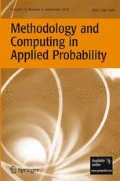Abstract
This paper presents the numerical solution of the process evolution equation of a homogeneous semi-Markov process (HSMP) with a general quadrature method. Furthermore, results that justify this approach proving that the numerical solution tends to the evolution equation of the continuous time HSMP are given. The results obtained generalize classical results on integral equation numerical solutions applying them to particular kinds of integral equation systems. A method for obtaining the discrete time HSMP is shown by applying a very particular quadrature formula for the discretization. Following that, the problem of obtaining the continuous time HSMP from the discrete one is considered. In addition, the discrete time HSMP in matrix form is presented and the fact that the solution of the evolution equation of this process always exists is proved. Afterwards, an algorithm for solving the discrete time HSMP is given. Finally, a simple application of the HSMP is given for a real data social security example.
Similar content being viewed by others
References
C. T. H. Baker, The Numerical Treatment of Integral Equations, Clarendon Press: New York, 1977.
E. Çinlar, Introduction to Stochastic Processes, Prentice Hall: Englewood Cliffs, New Jersey, 1975.
A. Csenki, Dependability for Systems with a Partitioned State Space (Markov and Semi-Markov Theory and Computational Implementation), Springer Verlag: Berlin, 1994.
R. De Dominicis and R. Manca, “An algorithmic approach to non-homogeneous semi-Markov processes,” Communication in Statistics, Simulation and Computation, Marcel Dekker, 1984a.
R. De Dominicis and R. Manca, “A computational procedure for the asymptotic analysis of homogeneous semi-Markov processes,” Statistics and Probability Letters, North Holland, 1984b.
D. A. Elkins and M. A. Wortman, “On numerical solution of the Markov renewal equation: Tight upper and lower kernel bounds,” Methodology and Computing in Applied Probability vol. 3 pp. 239–253, 2001.
S. N. Ethier and T. G. Kurtz, Markov Processes Characterization and Convergence, Wiley, 1986.
W. Freiberger and U. Grenander, A Short Course in Computational Probability and Statistics, Springer Verlag: Berlin, 1971.
R. Howard, Dynamic Probabilistic Systems, vol. II, Wiley, 1972.
J. Janssen and R. Manca, “Numerical solution of non-homogeneous semi-Markov in transient case,” Methodology and Computing in Applied Probability vol. 3 pp. 271–293, 2001.
J. Janssen, R. Manca, and E. Volpe, “Semi-Markov modelization for salary line evolution,” Proc. VIII ASMDA Symposium, Anacapri, 1997.
P. Levy, “Processus semi-Markoviens,” Proceedings of International Congress of Mathematics, Amsterdam, 1954.
R. Pyke, “Markov renewal processes with finitely many states,” Am. Math. Stat. vol. 32 pp. 1245–1259, 1962.
F. Riesz, Les systémes d'équations linéaires a une infinite d'inconnues, Gauthiers-Villars: Paris, 1913.
L. Yntema, “A Markovian treatment of silicosis,” Actas de la III Conf. Int. de Actuarios y Estadisticos de la Seguridad Social, Madrid, 1965.
Author information
Authors and Affiliations
Rights and permissions
About this article
Cite this article
Corradi, G., Janssen, J. & Manca, R. Numerical Treatment of Homogeneous Semi-Markov Processes in Transient Case–a Straightforward Approach. Methodology and Computing in Applied Probability 6, 233–246 (2004). https://doi.org/10.1023/B:MCAP.0000017715.28371.85
Issue Date:
DOI: https://doi.org/10.1023/B:MCAP.0000017715.28371.85




